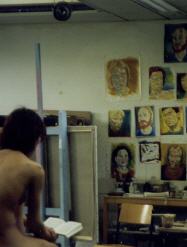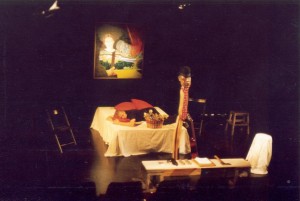Statement
I make visual and tactile works because they further my intellectual understanding of the surrounding world as well as amplify my emotional interaction with life as it is in this world.
I employ content and material to layer images and objects with numerous, distinct levels of meaning. Painting, visual images, sculpture, installation, performance, spoken word, music (blues, bluegrass, roots and jazz) are woven together in such a way as to charge up the incorporated static works with live energy.
These layers enrich one another, often in unexpected ways. Figuration is important to me when visible forms unveil invisible aspects of life.
The eye of the human is indeed an open window to the soul. My work revolves around the human to provide that eye with a functioning mirror with which to reflect, both earnestly and humorously, upon the meaning of being human and alive in this world – right now.
Background
Like many people, I am a visually-orientated individual.
A picture can speak a thousand words about a person, even as some words can evoke a thousand pictures. Here, in words, are some of the most valuable pictures that I have seen: long, warm afternoons spent in a row boat with a harmonica and a good book on a secluded Minnesota lake fishing for the evening’s meal and for winter; a tango down a long stretch of tables pausing for an intimately sensual kiss; an arduous hike over sand dunes up to the top ridge of Devil’s Playground in California to discover a phenomenal view, yet nothing diabolical – later, we get lost, temporarily;
Who art thou?
a dozen young Blackshirts without helmets riding loud motorcycles down empty Arizona highways laughing at racy stories; a bohemian summer in Paris drawing in parks, analysing architecture, shooting pool and smelling les Fleurs du mal in underground jazz clubs; a lover’s embrace looking out over a broad horizon of snow-capped Swiss alpine peaks;
Who art thou?
a gang of hooded homeboys throwing bricks at a suit running frantically down a grungy street, then they turn on me; the rush of adrenaline and success after completing something of worth against the odds, like victory over a tough opponent, an applauded public performance or a compelling spray of after-midnight graffiti across an ugly main street wall.
Who I am -
Making images and objects with the creative use of material has been the most constant activity in my life since my earliest memories in primary school of constructing scaled model cities out of cardboard and crayons.
Born in New York City during the summer of ’69, I was introduced at an early age to the fundamentals of drawing (perspective, crafting space, the difference between that which is seen and imagined), stretching canvas, grinding pigment, painting in oil and figurative clay relief.
As a restless teenager in Appalachia, I fell in love with many phenomena of beauty, including … antique hand tools, working with wood, playing the harmonica and the art of fishing. My enthusiasm grew for the jazzy efficacy of the spoken and written word.
During summers and after my study of glorious works made by dead, white men, I felt the wish to reconnect with the broad, contemporary world and the wacky ways of life lived by real people.
Travelling across America, Mexico, France, Germany and Switzerland, I encountered a wide variety of environments: in an Oklahoma hospital accompanying doctors on their rounds, observing operations and watching how the house and grounds crew tried to out-trick the management; as a goat herd making cheese in central France; as a guardian for autistic individuals in California; on the green chain and edger in an up-state New York lumber mill; as a night-shift baker with ski-fanatics in Colorado; on construction sites around Phoenix preparing concrete foundations and installing metal staircases.
As a horse groom in a winning racing stable, I saw the hustle behind the hype at a major horse track. As a short-order cook in a variety of diners, I came to know the daily routines and moods of waitresses, cooks, police officers, local lawyers, politicians and bums, of Colorado miners, Arizona truck drivers, biker outlaws and strippers.
To supplement my classically bookish education, I completed a mechanic’s certification in the company of a large clan of Harley Davidson bikers at a motorcycle school in Phoenix. Living in their biker-motel nearby, I blew harp with the in-house band Rocker Arm and helped the Blackshirts rebuild Redbeard’s ’52 Flathead at Uncle Bernie’s garage. They helped me renew the 1958 Triumph 6T Twin parked in my living room. The variety and raciness of their riotous way of life gave me a small treasure chest of stories about life “in the raw.”
The sheer multiplicity of values and lifestyles that I encountered effectively revoked the authority of theoretical, scholarly attempts to philosophize about our human species, our truths and our art.
I drew and wrote extensively, yet showed my works only to close friends or strangers in the night because they consisted mainly of verbal and visual portraits of friends, both clothed and unclothed, and caricatures of strangers. What fascinated me was the ability of lines or words to capture certain things: the inner character of a specific person conveyed by visual aspects, the unadorned beauty found in the human figure, moments of unleashed erotic energy or archetypes of human personalities.
I fell in love with metal at Skunk Creek Ironworks in the desert north of Phoenix, Arizona. After apprenticing to learn fabrication skills from the owner Ray Binion, he set me up managing the shop-work. At Skunk Creek, a pioneer spirit thrived, one of raw grit and freedom from societal and historical constraints.
From Ray I learned how to bring together shop efficiency and craftsmanship in service of unconventional experimentation through a wide variety of projects: reinforced stock car frames, horse feed silos, intricate wrought iron gates, rodeo belt buckles, miles of fencing panels and staircase runners.
Here I also accepted commissions for custom-made functional and non-functional furniture and completed a series of metal sculptures incorporating figurative elements carved in plaster.
The stories and adventures from these wander years are woven throughout the works that I make today.
In November, 1994, a new chapter in my life began. Leaving my tools and motorcycle in Phoenix to join my future wife in Switzerland, the next years were marked by oil painting, metalworking in the Williamsburg neighbourhood of New York City during its initial artistic bloom and the birth of the first of our two children in Austria.
I had never been very attracted to urban American art schools. In 1996, I found an academic studio in Graz, Austria that, combining rigour with innovation, appealed to me.
Under Gerhard Lojen (1935-2005), architect, painter and Director of the Ortweinschule Master’s Course for Painting, I became more familiar with the enriching art-historical context of works. Gerhard’s thorough comprehension of the progressive dynamics at work throughout the breadth of art history, with emphasis on 20th Century movements, helped open for me thrilling roads of expression.
From the German painter/sculptor Horst Reichle, (b. 1938) with whom I have worked intensively during numerous summer symposia since 1998, I continue to learn more details regarding the fusion of order and spontaneity, of abstracted figuration and lyrical expression, of worldly experience and youthful vigour.
The following visual artists have influenced my work decisively: Cennino Cennini, Ruebens, Picasso, Edward Hopper, Pollock, Kokoschka, Georgia O’Keeffe, Beuys, Rothko. Among living artists, Eric Fischl, Omar Galliani, Xenia Hausner, Olafur Eliasson and Banksy have impressed me with their extraordinary works.
My earlier college years studying western literature and philosophy were fuelled with the desire to learn more about our human species in the western world from Homer’s Iliad to Homer Simpson, the convolutions of our human development as the hero in this epic story from a geocentric, pantheistic warrior to a relativising, multi-theistic computer geek on the brink of a new digital age.
Other than sketches of nude co-eds, I did not draw or paint, rather focused on words, on the power of snappy scholarship and applied organization, on literary discipline and the clear, precise employment of verbal expression in service of “grand” ideas. Thesis: On the Journals and Papers of Søren Kierkegaard.
Whereas the interpretive layering of meaning – the socio-political, the poetic, the historical, the intimately personal, the metaphysical, and the conceptual among others – has a long tradition, weaving these layers through multi-medial expression offers vast regions of unexplored wilderness to explore, pioneer and develop.
Why should I make my works public at all?
The public exhibition of these works both recognizes the worth of such works to individuals and asserts the place of these works and of my vocation within the broader community of our contemporary global society.
In other words, I love making images and objects that enliven in various ways our human head, heart and loins.
– Shan Wardell
Pipe Creek, Austria, 2010


